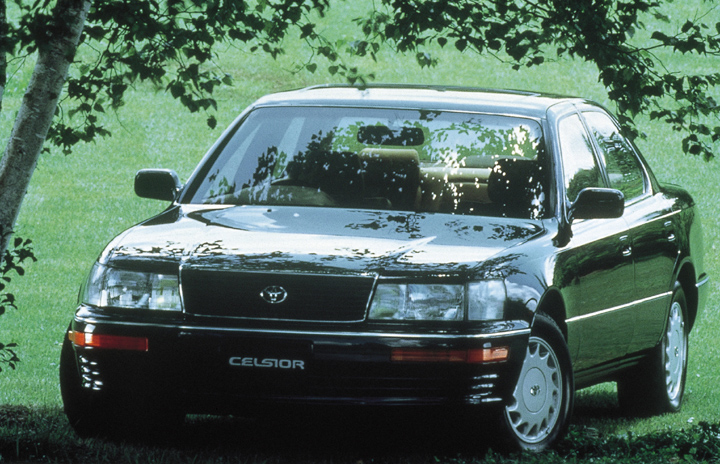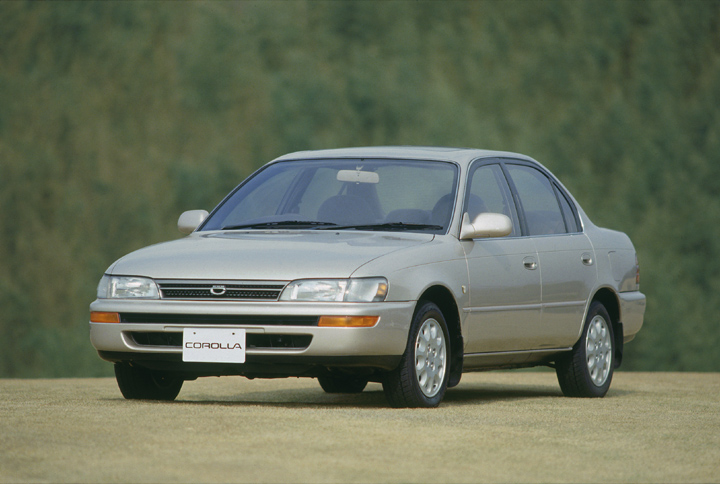Section 3. Rapid Growth of the Japanese Market and Development of the Lexus
Item 1. Achievement of Sales of 2.5 Million Vehicles in Japan
Responding to Japan's luxury automobile boom
With the eighth-generation Crown launched in August 1987, Toyota Motor Corporation (TMC) adopted a new product strategy designed to succeed in the luxury automobile boom, and introduced models, including one with a 4-liter V8 engine and a wide-body model with a 2-liter engine and "3 category" license plate. The strategy was designed to develop a new customer base by dramatically improving riding comfort and drivability through the adoption of features such as the Toyota Electronically Modulated Suspension (TEMS) and a traction control system.
The luxury automobile Cima launched in 1988 by Nissan Motor Co., Ltd. became explosively popular in Japan, especially among middle-aged and senior customers, creating the so-called "Cima Phenomenon", making the vehicle a symbol of luxury items during the bubble economy period. However, in terms of actual domestic sales volume in 1988, the Crown reached approximately 47,400 vehicles, outselling the Cima by more than 10,000 vehicles, and the Crown continued to lead afterward, as well. Moreover, according to the actual domestic sales volume for January of that year, the Crown took the No. 1 spot by beating the Corolla, which had always been Japan's bestseller, as the demand for luxury cars continued to overheat.
In October 1989, TMC launched the Celsior as a luxury car surpassing the Crown. The car's name is derived from the Latin word "Celsus" meaning "the ultimate" or "the highest". In the United States, the Celsior was named the LS 400, the highest-grade model of the Lexus luxury automobile sales network established there that year. Development of the Celsior had taken six years and as many as 450 prototypes. The Celsior with its high-quality build, fast acceleration, and quiet operation became so popular that the number of orders received in Japan instantly exceeded TMC's original expectation, resulting in a delivery time of nearly one year.
Beginning with the Celsior, TMC adopted a new emblem standardized on an elliptical design. The new design symbolized the advanced nature and reliability of the Toyota brand, with the center of two ellipses representing the bringing together of the heart of the customer and the heart of car making to symbolize the sense of trust thus born.
During this period, TMC also added luxury car features to the Corolla, which had been extremely popular as a people's car for many years. In the sixth-generation model launched in 1987, TMC used a "high-mecha twin cam" engine and adopted advanced technologies such as TEMS in the high-end model. Furthermore, in the seventh-generation model launched in 1991, the overall length and wheelbase were increased, and an upscale feel was strongly expressed in both the interior and exterior design of the vehicle and in how it was equipped. Although there had been internal hesitation over nudging the model up in class, the seventh-generation model intended to be a higher-grade and upper-class model turned out to be a major hit.
In the second-generation of the Soarer luxury coupe launched in 1986, TMC introduced a model equipped with electronically controlled air suspension; for the second-generation Carina ED launched in 1989, TMC introduced a dual-mode 4WS model. These models, which were generously equipped with world-first advanced technologies, also sold well.
As the Japanese luxury car boom also spread to imported cars, the number of new imported cars registered reached approximately 224,000 vehicles in 1990, growing five-fold over a period of 10 years. Japanese automakers successively introduced imported cars made by their foreign partners, for example, beginning in 1981, Suzuki Motor Co., Ltd. (now Suzuki Motor Corporation) launched cars made by General Motors Corporation (now General Motors Company) and Mazda Motor Corporation launched cars made by Ford Motor Company. With the goal of helping increase the number of cars imported into Japan, TMC also signed an agreement in July 1991 with Volkswagen (VW), with which TMC had been jointly producing compact trucks in Germany, to sell VW-made cars in Japan. Approximately 50 Toyota dealers that wished to carry the VW-made cars established new dealerships called "DUO" and began selling cars made by VW and Audi in 1992. TMC supported their sales activities with wholesaling and marketing.





